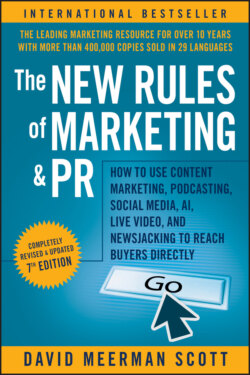Читать книгу The New Rules of Marketing and PR - David Meerman Scott, Kevin Nalty, Steve Garfield - Страница 32
The Long Tail of Marketing
ОглавлениеThe theory of the long tail as popularized by Chris Anderson in his book of the same name is that our culture and economy are increasingly shifting away from a focus on a relatively small number of major hits (mainstream products and markets) at the head of the demand curve and toward a huge number of niches in the tail. As the costs of production and distribution fall, especially online, there is now less need to lump products and consumers into one-size-fits-all containers. In an era without the constraints of physical shelf space and other bottlenecks of distribution, narrowly targeted goods and services can be as economically attractive as mainstream fare.
Some of today’s most successful Internet businesses leverage the long tail to reach underserved customers and satisfy demand for products not found in traditional physical stores. Examples include Amazon, which makes available at the click of a mouse hundreds of thousands of books and other products not stocked in local chain stores; Spotify and other services that legally bring niche music not found in record stores to people who crave artists outside the mainstream; and Netflix, which exploited the long tail of demand for movie rentals beyond the blockbuster hits found at the local DVD rental shop. The business implications of the long tail are profound and illustrate that there’s much money to be made by creating and distributing at the long end of the tail. Yes, big hits are still important. But as these businesses have shown, there’s a huge market beyond the latest Batman movie, U2, Taylor Swift, and Top Gear.
So, what about marketing? While Anderson’s book focuses on product availability and selling models on the web, the concepts apply equally well to marketing. There’s no doubt that there is a long-tail market for web content created by organizations of all kinds—corporations, nonprofits, churches, schools, individuals, rock bands—and used for directly reaching buyers—those who buy, donate, join, apply. As consumers search the Internet for answers to their problems, as they browse blogs and chat rooms and websites for ideas, they are searching for what organizations like yours have to offer. Unlike in the days of the old rules of interruption marketing with a mainstream message, today’s consumers are looking for just the right product or service to satisfy their unique desires at the precise moment they are online. People are looking for what you have to offer right now.
Marketers must shift their thinking away from the short head of the demand curve—mainstream marketing to the masses—and toward the long tail—a strategy of targeting vast numbers of underserved audiences via the web.
As marketers understand the web as a place to reach millions of micromarkets with precise messages just at the point of consumption, the way they create web content changes dramatically. Instead of a one-size-fits-all website with a mass-market message, we need to create just-right content—each aimed at a narrow target constituency. As marketing case studies, the examples of Netflix, Amazon, and Spotify are also fascinating. The techniques pioneered by the leaders of long-tail retail for reaching customers with niche interests are examples of marketing genius.
